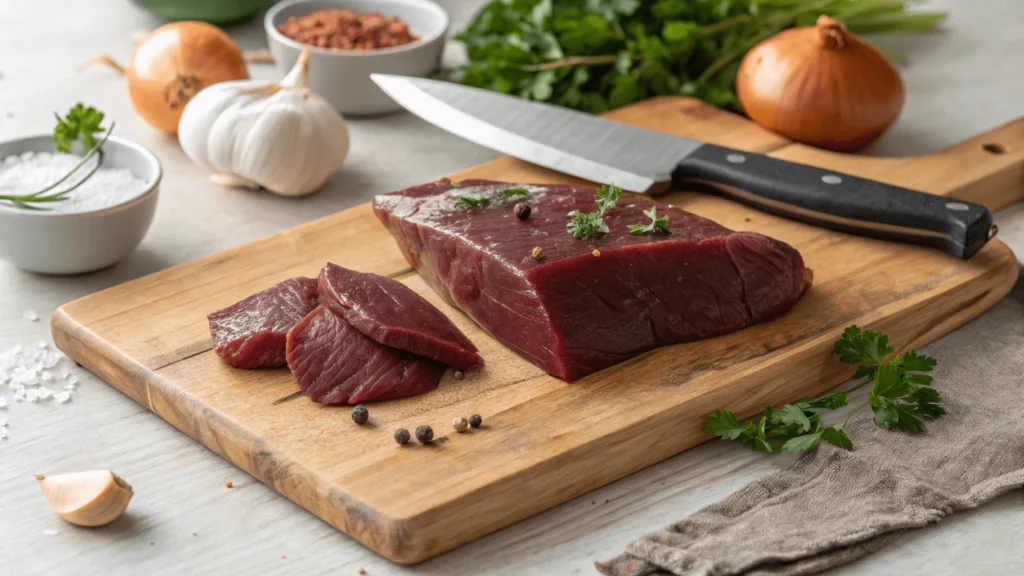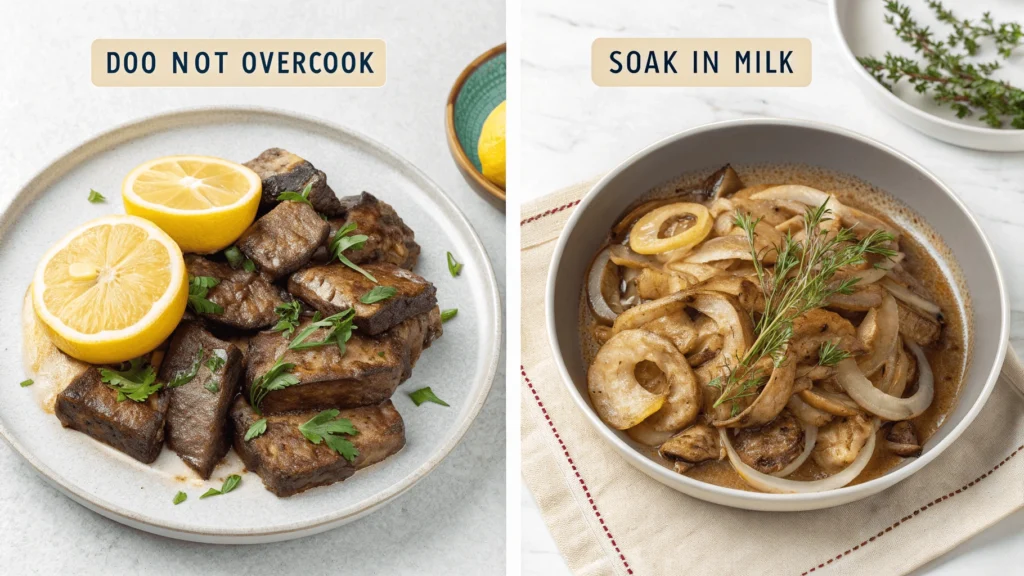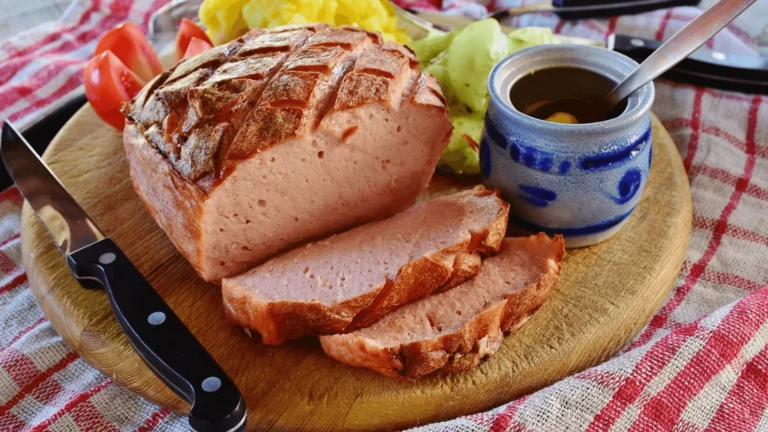Table of Contents
Introduction:
Beef liver might not be the first thing that comes to mind when planning dinner—but this humble cut is making a comeback, and for good reason. Packed with essential nutrients and rich in iron, vitamin A, and protein, beef liver is a powerhouse food that’s both budget-friendly and incredibly nourishing. Whether you’re exploring traditional recipes or looking to add variety to your weekly meals, beef liver offers a bold flavor and a wealth of health benefits. In this guide, we’ll walk you through why it’s worth a spot on your plate—and how to prepare it so it’s absolutely delicious.
Note: Below is the nutritional values table.

What Is Beef Liver?
Beef liver is the nutrient-dense organ meat harvested from cattle. It has a deep reddish-brown color, a soft but firm texture, and a rich, slightly metallic taste that’s unlike typical cuts of beef. Often called a “superfood,” beef liver is one of the most concentrated sources of vitamins and minerals available in any food.
Unlike muscle meat, liver serves as a storage house for nutrients the body needs to function—like iron, vitamin B12, folate, and vitamin A. While its strong flavor may be unfamiliar to some, proper preparation can turn beef liver into a surprisingly tasty and satisfying dish.
From pan-fried liver and onions to pâtés and stews, this cut is used in both classic American cooking and traditional dishes around the world.
10 Key Benefits of Beef Liver
- Rich in Iron
Beef liver is loaded with heme iron, which helps prevent fatigue and supports healthy red blood cell production—especially helpful for those with anemia. - Packed with Vitamin A
Just a small portion offers more than 100% of your daily vitamin A needs, essential for healthy skin, vision, and immune system strength. - High in Vitamin B12
One of the best natural sources of B12, beef liver supports brain health, energy production, and nervous system function. - Supports Detoxification
With nutrients like choline and zinc, liver helps your body naturally detox and function more efficiently. - Promotes Healthy Skin & Hair
Thanks to its high vitamin A and protein content, beef liver can support a glowing complexion and stronger hair. - Boosts Immune System
Loaded with essential nutrients like copper, selenium, and zinc, it helps your immune system defend against illness. - Improves Energy Levels
The B-complex vitamins, iron, and CoQ10 in liver contribute to better stamina and less fatigue throughout the day. - Strengthens Bones
Liver contains vitamin K2 and phosphorus, which are crucial for maintaining strong bones and preventing fractures. - Supports Mental Focus
With high choline content, beef liver may improve brain function, memory, and cognitive clarity. - Cost-Effective Superfood
Compared to other nutrient-rich foods, beef liver is affordable and easy to incorporate into meals without breaking the bank.
Ingredients for Beef Liver Recipe
| Ingredient | Quantity | Notes |
|---|---|---|
| Beef liver | 1 lb (about 450g) | Sliced into thin pieces |
| Milk (optional) | 1 cup | For soaking liver to mellow the flavor |
| All-purpose flour | ½ cup | For lightly coating the liver |
| Salt | 1 tsp | Adjust to taste |
| Black pepper | ½ tsp | Freshly ground preferred |
| Garlic powder (optional) | ½ tsp | Adds depth to the seasoning |
| Onion | 1 large | Thinly sliced |
| Butter or oil | 2 tbsp | For frying (use butter for richer flavor) |
| Fresh parsley (optional) | 1 tbsp | Chopped, for garnish |
Variations of Beef Liver Recipe
✅ Gluten-Free Version
| Ingredient | Swap / Tip |
|---|---|
| All-purpose flour | Replace with almond flour or gluten-free flour |
| Butter/oil | Ensure it’s gluten-free labeled if flavored |
| Seasonings | Double-check spice blends for hidden gluten |
📝 Tip: Almond flour gives a nice nutty flavor and browns well when frying.
🥩 Keto-Friendly Version
| Ingredient | Swap / Tip |
|---|---|
| All-purpose flour | Use coconut flour or skip coating entirely |
| Onion | Use in moderation (onions have natural sugars) |
| Milk (for soaking) | Use heavy cream or just water if you prefer |
📝 Tip: Pair with a side of cauliflower mash or sautéed spinach to stay keto!
🌶️ Spicy Version
| Additions | Amount |
|---|---|
| Cayenne pepper | ¼ to ½ tsp (adjust to heat) |
| Crushed red pepper | ½ tsp |
| Paprika (smoked) | 1 tsp |
| Jalapeño or chili | 1 small, sliced (optional) |
📝 Tip: Sauté sliced jalapeños with onions for a flavorful, spicy kick!
Cooking Instructions for Beef Liver
Step 1: Soak the Liver (Optional but Recommended)
- Place sliced beef liver in a bowl of milk or lemon water.
- Let it soak for 20–30 minutes to mellow out the strong flavor.
- Drain and pat dry with paper towels.
Step 2: Prep the Coating
- In a shallow bowl, mix:
- ½ cup flour (or almond flour for gluten-free)
- Salt and pepper to taste
- Optional: A pinch of paprika or garlic powder
- Lightly dredge each liver slice in the seasoned flour.
Step 3: Sauté the Onions
- In a large skillet, melt 1 or 2 tablespoons of butter or oil over medium heat.
- Add the onion slices and cook, stirring occasionally, until golden and caramelized, about 10–12 minutes.
- Remove onions and set aside.
Step 4: Cook the Liver
- In the same pan, add a bit more butter or oil if needed.
- Add coated liver slices in a single layer (do not overcrowd).
- Cook for 2–3 minutes per side until browned but still slightly pink in the center.
- Avoid overcooking — it becomes tough!
Step 5: Combine and Serve
- Return the cooked onions to the skillet.
- Let them warm through with the liver for 1–2 minutes.
- Optional: Deglaze the pan with a splash of beef broth, vinegar, or wine for extra sauce.
Ready to Serve!
Garnish with chopped parsley or chili flakes (if making spicy), and serve warm with mashed potatoes, sautéed greens, or cauliflower mash for keto lovers.

Expert Tips for Perfect Beef Liver
1. Soak for a Milder Flavor
To reduce the liver’s strong taste, soak it in milk, lemon juice, or even water with a splash of vinegar for 30–60 minutes. This helps mellow the flavor and tenderize the meat.
2. Slice It Thin and Even
Cut the liver into uniform, thin slices. This ensures it cooks evenly and quickly, preventing a tough texture.
3. Don’t Overcook It
Beef liver becomes chewy when overcooked. For best results, cook it on medium-high heat for 2–3 minutes per side until just browned but still soft inside.
4. Use Fresh Aromatics
Enhance the flavor by cooking liver with fresh garlic, onions, or herbs like thyme and rosemary. These pair well without overpowering the dish.
5. Season After Cooking
To avoid drawing out moisture, add salt and acidic ingredients like lemon juice after cooking. This keeps the liver juicy and flavorful.
6. Choose High-Quality Liver
Opt for grass-fed or organic beef liver if possible. It’s not only healthier but also has a cleaner, less metallic taste.
Conclusion
Beef liver may not be everyone’s first pick, but it’s a hidden gem packed with essential nutrients and rich flavor. Whether you’re looking to boost your iron intake, follow a keto lifestyle, or just try something new, this dish offers a hearty, satisfying experience. With the right preparation, seasoning, and cooking method, you can turn beef liver into a delicious and comforting meal. Try out one of the variations, and don’t be afraid to make it your own!
Frequently Asked Questions (FAQs)
1. Is beef liver healthy to eat?
Yes! Beef liver is considered a superfood. It’s incredibly rich in iron, vitamin A, B12, and protein—making it excellent for energy, immunity, and overall health.
2. How do I get rid of the strong taste of liver?
Soaking liver in milk or lemon juice for 30–60 minutes before cooking can help reduce its strong, metallic flavor.
3. Can I freeze cooked beef liver?
Absolutely. Cooked beef liver can be frozen in an airtight container for up to 2 months. Just thaw and reheat gently before serving.
4. What’s the best way to cook beef liver to keep it tender?
Avoid overcooking! Searing it quickly over medium-high heat for about 2–3 minutes per side keeps the texture soft and juicy.
5. Is beef liver good for a keto or low-carb diet?
Yes. It’s low in carbs and high in nutrients, making it ideal for keto and low-carb diets.
| Nutrient | Amount | Benefits |
|---|---|---|
| Protein | 20.4 g | Supports muscle repair, immune health, and overall body function |
| Carbohydrates | 3.9 g | Very low-carb, suitable for keto and low-carb diets |
| Vitamin A | 16,899 IU (337% DV) | Promotes eye health, skin regeneration, and immune support |
| Vitamin B12 | 70.6 µg (1176% DV) | Essential for red blood cell production and nervous system health |
| Iron | 6.2 mg (35% DV) | Helps prevent anemia and supports energy production |
| Folate (B9) | 290 µg (72% DV) | Crucial for DNA synthesis and during pregnancy |
| Vitamin C | 27 mg (45% DV) | Boosts immunity and aids iron absorption |
| Zinc | 4.0 mg (36% DV) | Supports immune function and wound healing |
Note: Values are approximate and based on USDA data. %DV = Percent Daily Value based on a 2,000-calorie diet.

